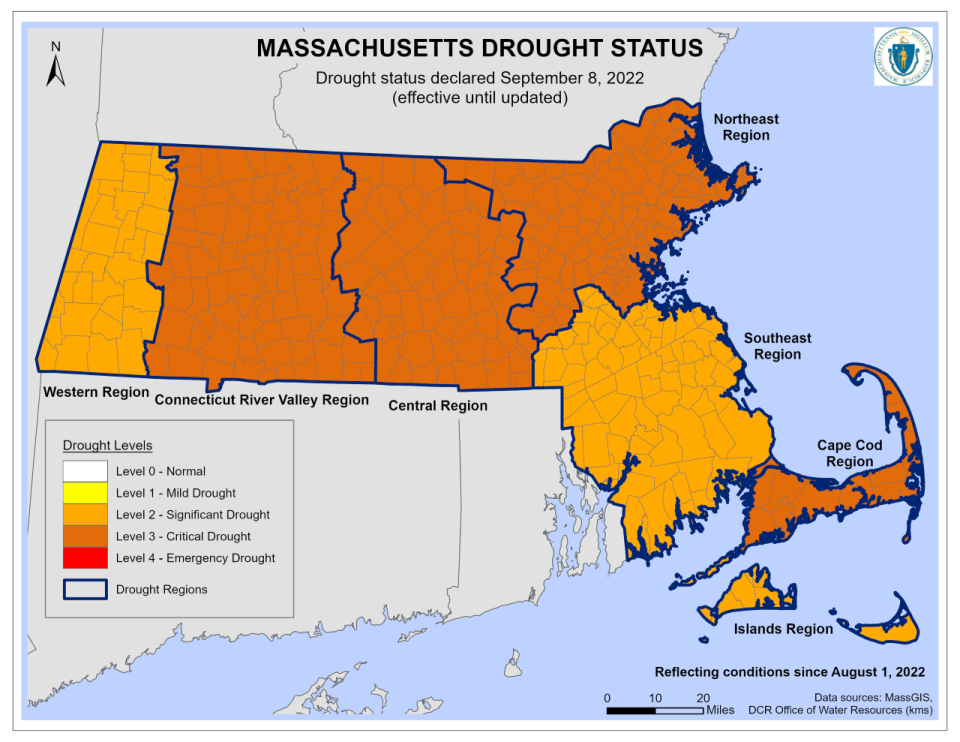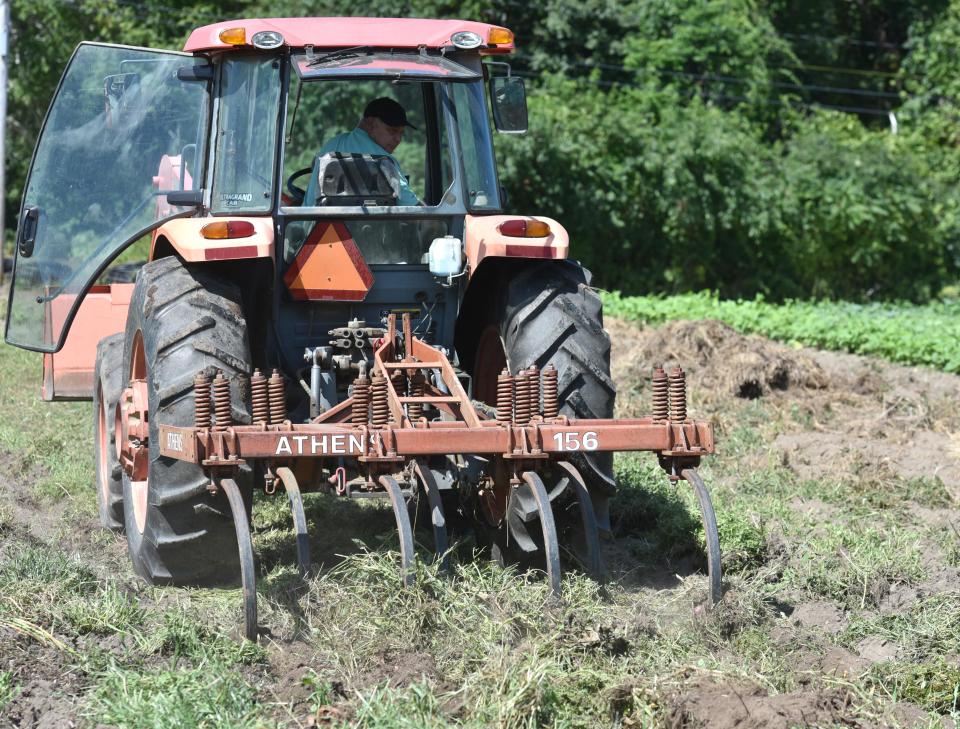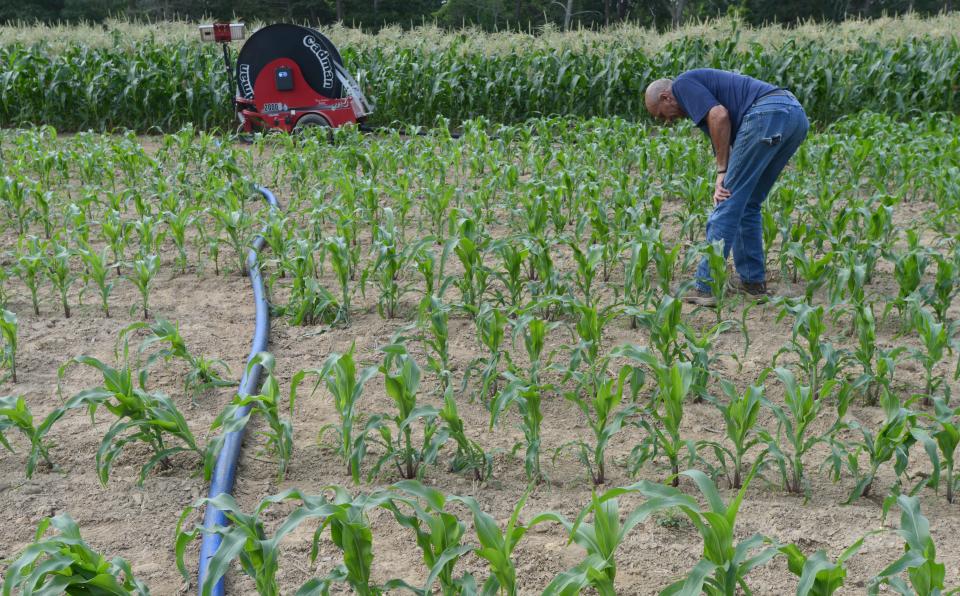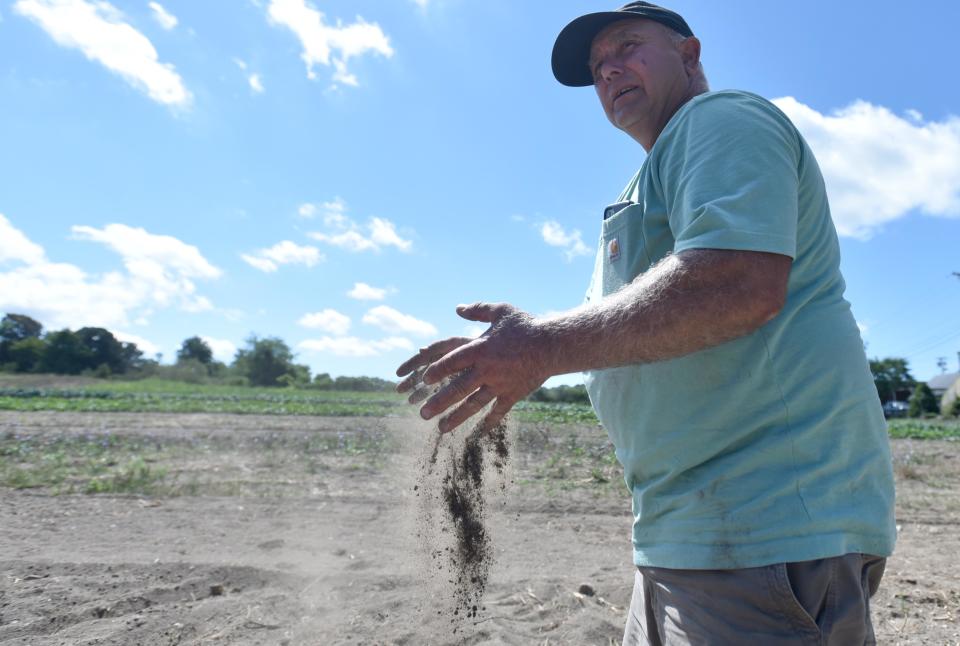Too little, too late: Drought remains 'critical' despite rainfall, cooler weather
Recall the rain that came, finally, just last week; and now a little more as the second full week of September arrives? East Falmouth farmer Geoff Andrews, who operates Tony Andrews Farm, has two words for it: "Dust control." And nothing more.
"It didn't do nothing for us," he said.
As one who makes a living of working the land, Andrews doesn't need a rain gauge or a meteorological report to know whether there's been enough rain to end a drought. He already knows what state environmental authorities are reporting: Despite the few days of gray and rain September has brought so far, Cape Cod remains at a level three "critical" drought.
Apart from the western quarter of the state, Martha's Vineyard, and Nantucket, as well as the southeastern corner of Massachusetts — where last week's rainfall slightly improved the drought status from "critical" to level two "significant" drought — the rest of the state also remains in a "critical" drought.
“While recent precipitation across the state has brought some improvements to streamflow and local water supplies, we still have a ways to go. The Commonwealth continues to experience widespread drought in every region of the state,” Massachusetts Energy and Environmental Affairs Secretary Beth Card said.

here has been "quite a large variation in rainfall" in the northeast. The highest totals were across northern Connecticut into southeastern Massachusetts west of the Cape Cod Canal, where totals ranged from 3-6 inches, with few localized areas over 6 inches — near normal to more than 3 inches above normal, according to the National Oceanic and Atmospheric Administration's National Weather Service.
Tracking the rainfall
The lowest rainfall amount was in western and northern Massachusetts, and the Cape and islands, coming in at 1 to 3 inches below normal. Cape Cod, Martha’s Vineyard, and Nantucket reported less than 2.5 inches of rainfall during the month of August.
During the first week of September, according to the National Weather Service, 6 inches of rain fell across most of the state, with the exception of the Cape and Islands, which reported less than an inch of rain.
Meanwhile, temperatures in August averaged 3 to 7 degrees above normal.
"This summer's combination of mainly below normal rainfall, and above to much above normal temperatures, caused drought conditions to deteriorate throughout the season," the National Weather Service indicated in a Sept. 9 advisory.
Noting that groundwater levels "are typically slower to respond to drought conditions," the weather service reported that groundwater levels across southern New England continue to range from "normal to much below normal."
"Soil moisture was below to much below normal, except for localized areas affected by recent thunderstorms," the agency said.
'96 days too late'
'Tim Friary, of Barnstable's Cape Cod Organic Farm, shares Andrews' assessment of the late-season precipitation. Although the small amount of rain gives him brief respite from this summer's constant watering chore, it's not providing any measurable help.
"As far as doing anything substantial for the drought, it hasn't done anything," he said.

Andrews said the rain is "96 days too late" to be of any help. He's kept his 28 acres of crops alive through constant, day-in and day-out irrigation efforts and sheer determination.
"We've spent $8,000 just in irrigation," he said, "$600 is the normal."
The amount he's spent on irrigation, Andrews said, is comparable to giving away three acres of corn.
He's seen dry years before, but "this was the worst season in the world...the worst I've seen. It's like Arizona or New Mexico."
It doesn't help that Cape Cod has so-called "Carver coarse soil" to contend with.
"It doesn't retain any moisture." he said. "It is brown sand."
Andrews likens the Cape Cod soil to a "bone dry" kitchen sponge — when you put it under water, "the water runs off real quick" instead of soaking in. The sponge must first be allowed to soak for a while before it can be wrung out and become useful. He applies this idea to his irrigation method, saying he first moistens the soil to get it damp before doing full-on irrigation.
"Now it's going to retain that water," instead of running off, he explained. Andrews has been irrigating 12 hours a day every day since June 15. It's time consuming, and expensive.
"Fifty eight, 59 days into the drought? I almost called it quits," he said. But, "I don't like failure. I'm broke, but I won. It's through the thick and the thin. I'm trying to keep this legacy alive for my dad."

Andrews does worry about fellow farmers, especially those who may be nearing a decision on retirement or those who have just started farming, calling this year "a true test" to any farmer.
He's part of a cooperative of local farmers who have commiserated over the challenges of the drought, and the challenges of doing so on Cape Cod, with its uniquely difficult soil and unique restrictions on soil additives — not to mention the worries about the impacts of climate change on their livelihood. Some have talked about giving it all a rest.
"I give them a little push. They want to retire. I tell them 'stick with it, stick with it," Andrews said.
This is the kind of year, he said, "to break a farmer."
Friary agrees that farmers are facing an uphill battle, not only with the current drought, but as they look toward the future. Climate change brings "events" with it, he said.
"Unfortunately, right now, it's a drought," he said.
The next one could be a major hurricane, he said, or overly cold temperatures, or too much rain.
"I don't think anything is going to be small anymore," Friary said.

The state Department of Energy and Environmental Affairs recognizes the effect the drought has had on the agriculture sector, noting that in some areas it has resulted in depletion of water sources and production acreage, an increase in irrigation of crops, lower than normal yields, undersized fruits or vegetables, and higher operating costs.
To assist farms, on Aug. 15, the United States Department of Agriculture designated nine Massachusetts counties — including Barnstable County — as primary natural disaster areas and three counties as contiguous disaster areas due to the 2022 drought.
"A USDA secretarial disaster designation makes farm operators in the primary and contiguous counties eligible to be considered for assistance from the Farm Service Agency (FSA), such as FSA emergency loans, provided eligibility requirements are met," the state agency said. "Farmers in eligible counties have eight months from the date of the disaster declaration to apply for emergency loans."
More information about the USDA’s Disaster Assistance Programs can be found at www.fsa.usda.gov/programs-and-services/disaster-assistance-program/index
The U.S. Small Business Administration also announced federal Economic injury Disaster Loans are now available in the designated and contiguous counties. Small businesses, small agricultural cooperatives, small businesses engaged in aquaculture, and most private nonprofit organizations with economic losses due to drought would be eligible for the loans. More information can be found at www.sba.gov
Key: Water conservation and wildland fire control
As "critical" and "severe" drought conditions continue, the state Drought Management Task Force and other environmental authorities are urging people to continue taking precautions to prevent wildland fires, and to be careful about their water use.
“While a good deal of helpful rain has fallen over the past few days in many areas of the Commonwealth, it is important to remember that the drought’s impacts have taken months to develop and will take more than a few days of rain to resolve,” Massachusetts Emergency Management Agency Acting Director Dawn Brantley said. “Hopefully, we will continue to get additional rain, but until then, we need to continue to be mindful about our day-to-day water use and remain vigilant in preventing brush and wildfires in our communities.”
According to the Department of Energy and Environmental Affairs, there have been about 905 reports of wildland fires in the state to date, burning an estimated 1,485 acres. A total of 137 fires were recorded just in August "during some of the highest drought indices since 2016" — in comparison, there were 24 wildland fires reported in August 2021.
Until further notice, the Department of Conservation and Recreation has called for a temporary ban on all open flame and charcoal fires within state park properties.
During the ban, small portable propane grills are still allowed at campgrounds and recreation areas where grilling is permitted.
Water use recommendations have also been issued, in addition to a reminder to check if more stringent local watering restrictions are in place.
In the level 3 "critical" drought areas, residents and businesses are urged to stop all non-essential outdoor watering and minimize overall water use.
In the level 2 "significant" drought areas, residents are businesses are urged to minimize overall water use, limit outdoor watering to hand-held hoses or watering cans after 5 p.m. or before 9 a.m.
“It takes time to recover from a drought. Understanding that fact and the variations in rainfall by location across the Commonwealth, water users should continue to follow the advice of their public water system and conserve as much water as possible,” said MassDEP Commissioner Martin Suuberg.
State agencies are continuing to monitor and assess the drought conditions and any impacts. The Drought Management Task Force will meet again on Sept. 22.
To get the most up-to-date information on the drought indices, visit the state’s drought dashboard page at www.mass.gov/info-details/massachusetts-drought-resources
Additionally, the Commonwealth is surveying the public for drought impacts. To participate, visit the Massachusetts Water Impact Reporter webpage at tinyurl.com/MAdroughtsurvey
This article originally appeared on Cape Cod Times: Cape Cod drought: No relief despite recent rain

